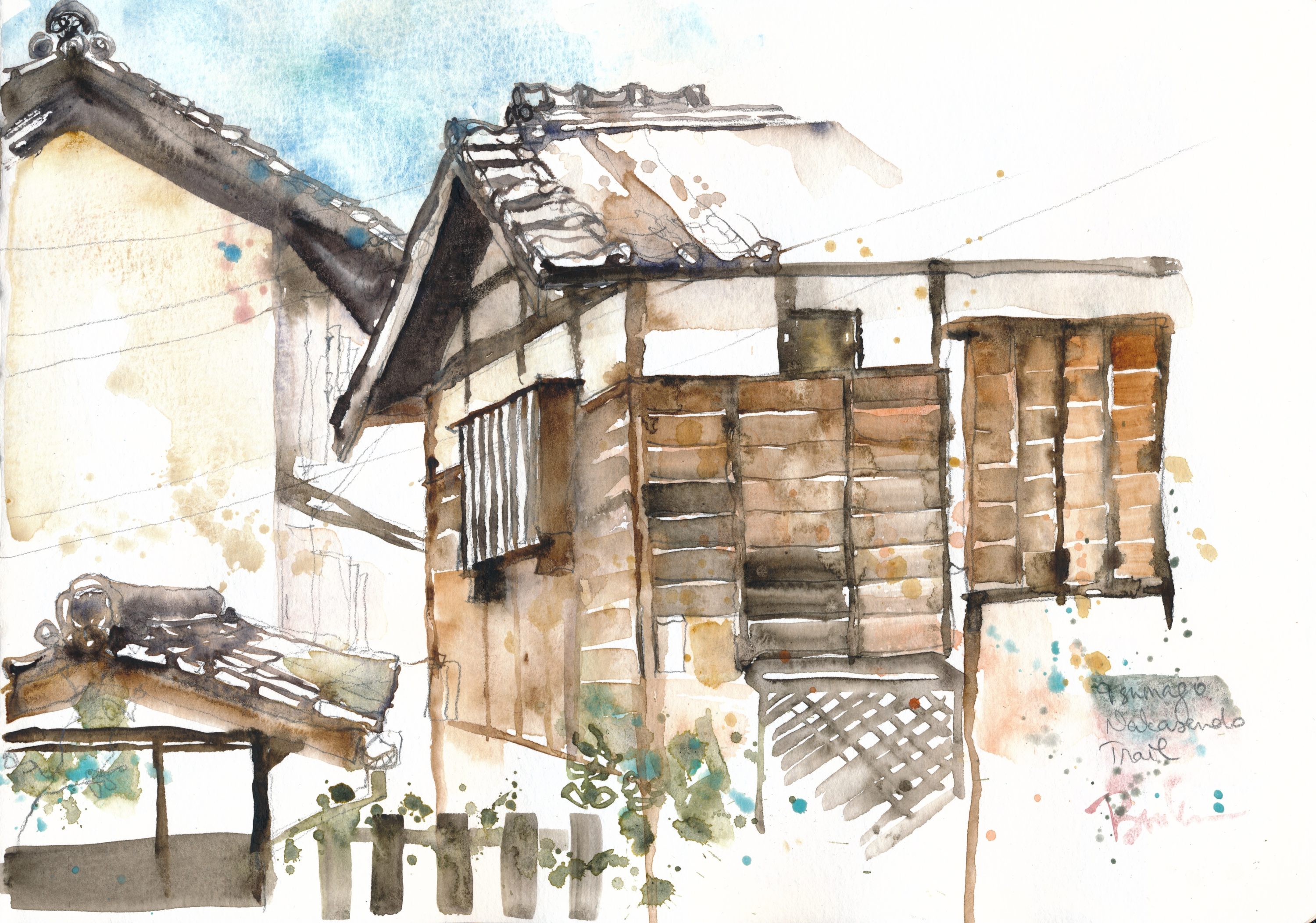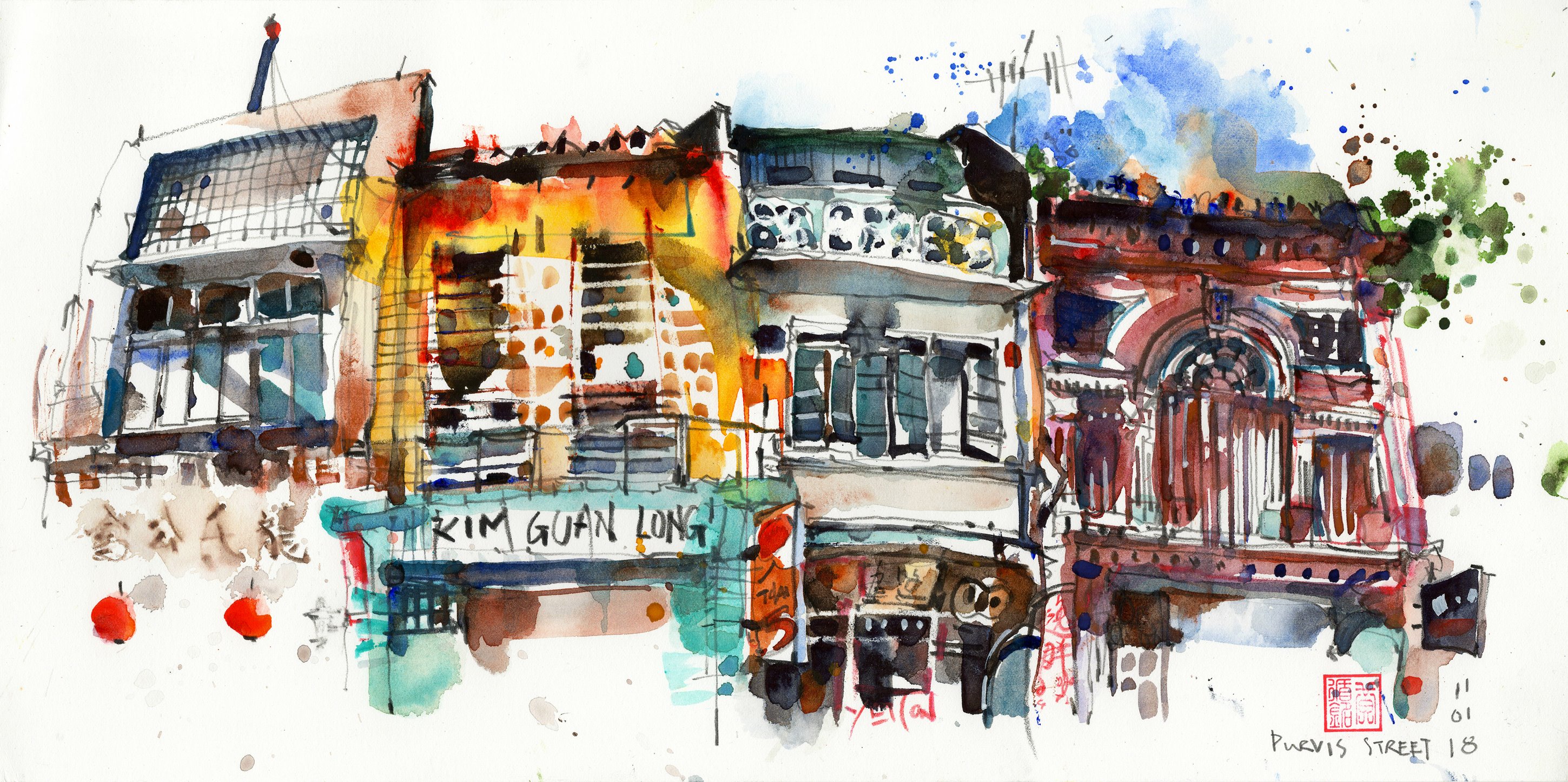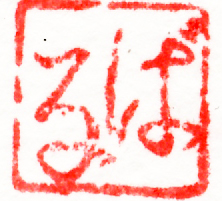Today I want to try to answer this great question I received from Dana:
” I really love sketching buildings and architecture but struggle with getting the size of what I want to draw, right on the page I’m working on, and correct (or close to correct) scale and proportion of what I’m drawing. I’ve studied some of the proportion techniques and measuring, but I still find it so difficult! Any advice?”
Thank you so much for your great question, Dana !
I still struggle sometimes with this as well! Some days it goes better then other days!
I’ll try to give some tricks here, inspired also from other artists I like, because there are several ways which “lead to Rome”…
The most classical way is to first draw the overal shapes of the buildings you want to have on your page: I mean: draw first the contours of the buildings. Something that works well is that I first look carefully, at least 5 minutes, before I start drawing. I figure out what’s my focal point, and what I find most important in the scenery. Then I “draw” the shape on the page with my finger: just indicating the contour of the building to have the size in mind. What you can do then is draw the contour of the shapes on the page, like does Ian Fennelly (see video below). He first sketches the main shapes with a light grey marker.
I made several sketches this way and it works very well !
But most of the time I prefer to draw more “organically”….
I then start drawing with what I like most in the building… and it happens that the building then doesn’t fit on the page… What I do then is that I just stop drawing. I leave the building unfinished. That’s ok, because our brain completes what’s missing. It’s even quite nice to leave white on the page. It makes your drawing breathe.
Below you see an unfinished drawing. It’s a view from my hotel window in Tsumago, Japan. What’s important then to do, is to leave those parts of the drawing without details, and to leave some white paper… so it looks like you did it on purpose 😉 …

And here’s a painting from Paul Wang. You see the bottom of the building is not on the painting… He does this a lot : just paint the part of the building you like most…

Now I want to try to answer the other part of the question: how to get the proportions right!
There are several measuring tricks of course. If you want to measure with your pencil: make sure to hold out your arm straight, and keeping your pencil straight, in the vertical plane, as your paper is a flat surface! Another trick is to have a transparent sheet with a grid on it and look through that, so you can see with the grid, the proportions of everything.
This is best explained in Betty Edwards book: “Drawing on the right side of the brain”.
The basic perception skills defined by Betty Edwards:
- the perception of edges (seeing where one thing ends and another starts)
- the perception of spaces (seeing what lies beside and beyond)
- the perception of relationships (seeing in perspective and in proportion)
- the perception of light and shadows (seeing things in degrees of values)
- the perception of gestalt (seeing the whole and its parts)
Here’s some other “trick” to keep in mind:
To avoid overwhelm, look at your subject as just “a bunch of lines”
How do you look at the building you want to draw? How do you look at the Musée du Louvre to draw it? If you look at it as the Musée du Louvre with the impressive perspective and sculptures, cold sweat and fear will take over. If you look at it simply as a bunch of lines that you want to suggest on the paper (and so it doesn’t matter really if some of them will be missing), then it starts to be fun. So don’t see the building as a building, and don’t try to draw everything. And also: it doesn’t matter if you drawing isn’t “correct” ! Who cares? If we want to see all the lines and all the sculptures it’s better to take a photograph, isn’t it?
Just look at the lines, the edges, and look in which direction they’re going, and try to put that direction on your paper. Don’t JUDGE what you see. Trust your eyes! And look at the proportions this way: “that line, how long is it compared to the previous line?”
To be able to see the building as a bunch of lines, what you have to do is look with your eyes, and not with your brain. Look with your eyes to the lines, to the contours of surfaces and draw them. Don’t look with your brain to the building, windows, chairs, glass or whatever you want to draw. Just look at the edges of the subject and in which direction the lines are going. If you don’t see in which directions the lines are going, make a plastic sheet with a grid on it and look through the plastic sheet.
I hope this explanation is of some help?
If not, don’t hesitate to ask your questions in the comments below!
I’ll end with this “bunch of lines” from the great artist Ch’ng Kiah Kiean !



This is wonderful and very helpful Barbara. Thank you for for taking the time to share excellent advice and wisdom and address my question. I’ll be putting it all into practice. 🙂 Dana
Thank you so much Dana!
I’m very happy you found it helpful !
Dear Barbara,
I miss your daily drawing/painting inspirations. This advice along with the photos is much appreciated.
Thank-you for sharing.
Hi Joy-marie!
thank you so much !
I’ll be doing some new videos in the coming days so stay tuned on my You Tube channel 🙂
Thank you so much. This information was so practical and useful. It certainly reduced my “fear factor”. Now my inner voice will chant, “Look at the lines”.
Wonderful! Thank you so much for your generous comment ‼️❤️❤️❤️
Our dear Barbara, you always share solid advice with warmth & generosity; so appreciated.
#StaySafe
Love,
valOrie
❤️❤️
To me it’s always calming to know that a professional artist faces the same problems, sometimes, as I do…
Merci ma chère 🙂
This is a helpful post, Barbara. It’s good to be reminded of these things and to remember that you can just fade it out and not capture everything …. and it’s okay….. even good!
Thank you dear Carla !
Yes it’s even better to draw less and just also work with “suggestions” !
Hello Barbara! I’ve only just “discovered” you this evening from a post re; your book, Kisetsu, which looks completely charming! Thank you for your gracious and helpful suggestions.
I look forward to learning more about you and your lovely art!
Thank you so much dear Debra ! Tell me if you have any technical questions you like to read about?
Thanks so much this is helpful to me as a beginner at exploring watercolour and ink. I’m trying to improve my drawing skills.
Hi Doris, how are you?
Tell me if you have questions I can help you with.